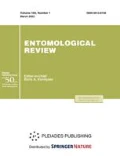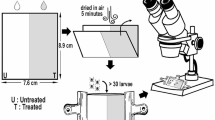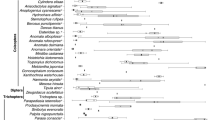Abstract
A comparative study on the effect of light and temperature on the daily rhythm of adult eclosion was carried out on the blood-sucking mosquitoes Aedes (Ochlerotatus) communis De Geer and Culex pipiens pipiens L. Two forms of C. p. pipiens were investigated: the autogenous form molestus occurring in the underground habitats (the urban mosquito), and the anautogenous form pipiens inhabiting mostly the above-ground biotopes. The study included both field observations and laboratory experiments. Under natural conditions (southern Karelia, 62°N) at optimal temperatures A. communis and C. p. p. f. pipiens demonstrated a bimodal eclosion rhythm with morning and evening peaks, whereas in C. p. p. f. molestus only an evening maximum was observed. The fraction of adults eclosing in the middle of the day increased at lower temperatures. In all the mosquitoes studied, the daily eclosion dynamics in the nature did not differ significantly between the variants with different levels of illumination, suggesting that temperature was the main factor regulating the eclosion rhythm. However, experiments with constant temperature showed that light also could influence the timing of eclosion. The responsiveness to light was different in two studied forms of C. p. pipiens. Under a constant temperature and light-dark cycles the rhythm became weak or disappeared completely in the mosquitoes from above-ground biotopes (A. communis and C. p. p. f. pipiens) but persisted in the urban mosquito. The effect of gradual twilight transitions was more prominent than that of switching the light on or off abruptly. The observed differences in the light and temperature dependence of the eclosion rhythm are discussed in relation to the ecological conditions in different habitats.
Similar content being viewed by others
References
Broomer-Korvenkontio, M., Kornonen, P., and Hameen-Anttila, R., “Ecology and Phenology of Mosquitoes (Diptera, Culicidae) Inhabiting Small Pools in Finland,” Acta Entomol. Fenn. 28, 51–73 (1971).
Chernyshev, V.B., Daily Activity Rhythms of Insects (MGU, Moscow, 1984) [in Russian].
Chernyshev, V.B., Insect Ecology (MGU, Moscow, 1996) [in Russian].
Chiba, Y., Kubota, M., and Nakamura, Y., “Differential Effects of Temperature upon Evening and Morning Peaks in the Circadian Activity of Mosquitoes, Culex pipiens pallens and Culex pipiens molestus,” J. Interdisc. Cycl. Res. 3, 55–60 (1982).
Chiba, Y., Uki, M., Kawasaki, Y., Matsumoto, A., and Tomioka, K., “Entrainability of Circadian Activity of the Mosquito Culex pipiens pallens to 24-hr Temperature Cycles, with Special Reference to Involvement of Multiple Oscillators,” J. Biol. Rhythms 8(3), 211–220 (1993).
Chiba, Y., Yamakado, C., and Kubota, M., “Circadian Activity of the Mosquito Culex pipiens molestus in Comparison with Its Subspecies Culex pipiens pallens,” Int. J. Chronobiol. 7(3), 153–164 (1981).
Christine, D., “Emergence and Its Diel Periodicity in Aedes (O.) communis (DeG.), punctor (Kirby) and hexodontus Dyar in Swedish Lapland,” Aquilo Ser. Zool. 14, 34–45 (1973).
Clopton, J.R., “A Circadian Rhythm in Spontaneous Locomotor Activity in the Larvae and Pupae of the Mosquito, Culiseta incidens,” Physiol. Entomol. 4, 201–207 (1979).
Coluzzi, M., “Inversion Polymorphism and Adult Emergence in Anopheles stephensi,” Science 176, 59–60 (1972).
Corbet, P.S., “Diel Patterns of Mosquito Activity in a High Arctic Locality,” Canad. Entomol. 98(12), 1238–1252 (1966).
Gutsevich, A.V., Monchadskii, A.S., and Stackelberg, A.A., Fauna of the USSR. Diptera. Vol. 3, Issue 4. Mosquitoes of the Family Culicidae (Nauka, Leningrad, 1970) [in Russian].
Helfrich-Forster, Ch., “Differential Control of Morning and Evening Components in the Activity Rhythm of Drosophila melanogaster-Sex-Specific Differences Suggest Different Quality of Activity,” J. Biol. Rhythms 15(2), 135–154 (2000).
Helfrich-Forster, Ch., “The Locomotor Activity Rhythm of Drosophila melanogaster is Controlled by a Dual Oscillator System,” J. Insect Physiol. 47, 877–887 (2001).
Jones, M.D.R., “Coupled Oscillators Controlling Circadian Flight Activity in the Mosquito, Culex pipiens quinquefasciatus,” Physiol. Entomol. 7, 281–289 (1982).
Kon, M., “Activity Patterns of Chironomus yoshimatsui (Diptera, Chironomidae). I. Effects of Temperature Conditions on the Adult Activity Patterns,” J. Ethol. 3, 131–134 (1985).
Kukharchuk, L.P., Ecology of Blood-Sucking Mosquitoes in Siberia (Diptera, Culicidae) (Novosibirsk, 1981) [in Russian].
Kureck, A., “Two Circadian Eclosion Times in Chironomus thummi, Alternately Selected with Different Temperatures,” Oecologia 40, 311–323 (1979).
Lankinen, P. and Riihimaa, A., “Effects of Temperature on Weak Circadian Eclosion Rhythmicity in Chymomyza costata (Diptera: Drosophilidae),” J. Insect Physiol. 43(3), 251–260 (1997).
Monchadskii, A.S., “Feeding of Mosquitoes on Man under the Subarctic Natural Conditions and Factors of Its Regulation,” Parazitol. Sbornik Zool. Inst. Akad. Nauk SSSR, no. 12, 123–166 (1950).
Muller, K., “Circadian Rhythms of Locomotor Activity in Aquatic Organisms in the Subarctic Summer,” Aquilo Ser. Zool. 14, 1–18 (1973).
Pittendrigh, C.S., “Circadian Rhythms and the Circadian Organization of Living Systems,” in Cold Spring Harbor Symposium on Quantitative Biology, Vol. 25 (1960), pp. 159–184.
Reiter, P. and Jones, M.D.R., “An Eclosion Timing Mechanism in the Mosquito Anopheles gambiae,” J. Entomol. A 50(3), 161–168 (1975).
Riemann, J G., “Effect of Thermoperiod and Photoperiod on the Eclosion Rhythm of the Sunflower Moth (Lepidoptera: Pyralidae),” Environ. Entomol. 20(5), 1322–1326 (1991).
Riihimaa, A., Genetic Variation in Diapause, Cold-Hardiness and Circadian Rhythm in Chymomyza costata (University of Oulu, 1996).
Saunders, D.S., Insect Clocks, 3rd ed. (Elsevier, Amsterdam etc., 2002).
Shinkawa, Y., Takeda, Sh.-I., Tomioka, K., et al., “Variability in Circadian Activity Patterns within the Culex pipiens Complex (Diptera, Culicidae),” J. Med. Entomol. 31(1), 49–56 (1994).
Sychevskaya, V.I., “Seasonal and Daily Shifts of the Temperature Activity Limits in Synanthropic Species of the Genus Fannya R. D.,” Zool. Zh. 33(3), 637–643 (1954).
Taylor, B. and Jones, M.D.R., “The Circadian Rhythm of Flight Activity in the Mosquito Aedes aegypti (L.): the Phase Setting Effects of Light-on and Light-off,” J. Exp. Biol. 51, 59–70 (1969).
Tomioka, K., Sakamoto, M., Harui, Y., and Matsumoto, N., “Light and Temperature Cooperate to Regulate the Circadian Locomotor Rhythm of Wild Type and Period Mutants of Drosophila melanogaster,” J. Insect Physiol. 44, 587–596 (1998).
Vinogradova, E.B., “Mosquitoes of Culex pipiens Complex in Russia,” Trudy Zool. Inst. RAN 271, 1–307 (1997).
Waterhouse, J. and Minors, D., “Masking and Entrainment,” Adv. Biosci. 73, 165–171 (1988).
Yoshii, T., Sakamoto, M., and Tomioka, K., “A Temperature-Dependent Timing Mechanism is Involved in the Circadian System that Drives Locomotor Rhythms in the Fruit Fly Drosophila melanogaster,” Zool. Sci. 19, 841–850 (2002).
Zdarek, J. and Denlinger, D.L., “Change in Temperature, not Photoperiod, Control the Pattern of Adult Eclosion in the Tse-Tse, Glossina morsitans,” Physiol. Entomol. 20, 362–366 (1995).
Zinov’eva, K.V., Reznik, S.Ya, Zaslavsky, V.A., and Umarova, T.Ya., “The Effects of Photoperiod and Thermoperiod on the Daily Eclosion Rhythm of Alysia manducator (Hymenoptera, Braconidae) and Trichogramma evanescens (Hymenoptera, Trichogrammatidae),” Zool. Zh. 75(10), 1496–1504 (1996).
Zotov, V.A., “Daily Activity Rhythm of the Darkling Beetle Trigonoscelis gigas Reitter (Coleoptera, Tenebrionidae) and Its Regulation by Light and Temperature,” Zool. Zh. 59(2), 217–224 (1980).
Zotov, V.A., “Exogenous and Endogenous Components of the Daily Activity Rhythm in the Ladybird Coccinella septempunctata L. (Coleoptera, Coccinellidae),” Zool. Zh. 62(11), 1654–1662 (1983).
Author information
Authors and Affiliations
Additional information
Original Russian Text © S.G. Karpova, 2009, published in Entomologicheskoe Obozrenie, 2009, Vol. 88, No. 2, pp. 241–256.
Rights and permissions
About this article
Cite this article
Karpova, S.G. Effect of light and temperature on the daily rhythm of adult eclosion in the blood-sucking mosquitoes Aedes communis De Geer and Culex pipiens L. (Diptera, Culicidae). Entmol. Rev. 89, 377–389 (2009). https://doi.org/10.1134/S0013873809040010
Received:
Published:
Issue Date:
DOI: https://doi.org/10.1134/S0013873809040010




